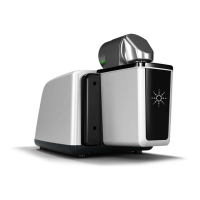Introduction
8 Agilent Cary 630 FTIR Spectrometer User’s Guide
The Cary 630 FTIR uses technology known as Fourier transform
infrared (FTIR) spectroscopy, which is the current state-of-the-art
technique for molecular compound identification and quantification.
FTIR uses an infrared light source to pass through the sample and
onto a detector, which precisely measures the amount of light
absorbed by the sample. This absorbance creates a unique spectral
fingerprint that is used to identify the molecular structure of the
sample and determine the exact quantity of a particular compound in
a mixture. At the heart of the Cary 630 FTIR spectrometer is a unique
Michelson interferometer. This proprietary design is the key to making
FTIR technology compact, lightweight and rugged.
The Cary 630 FTIR is available in two configurations depending on the
frequency range necessary for your application. Please see the Cary
630 FTIR specifications for details.
In addition, a number of different sampling accessories are available
to suit various sample types and sensitivities. The accessories
accommodate the analysis of a range of liquids, powders, gases, pastes
and gels. They include:
Diamond ATR: For the chemical analysis of liquids, powders,
pastes and gels. The attenuated total reflectance (ATR) system is
available as a single-reflection (most common) ATR.
ZnSe ATR: For the chemical analysis of liquids, gels and soft
solids within a pH range of 5-9. The attenuated total reflectance
(ATR) system is available as a single-reflection ATR (most
common) and a multi-bounce ATR (Liquids only)
Transmission: A classic infrared sampling interface, allowing
measurement of solids, liquids and gases. A 50 mm slide-mount
gas cell is also available from Agilent.
TumblIR: Single pathlength transmission for rapid chemical
analysis of liquids under ambient conditions.
DialPath: For rapid chemical analysis of liquids under ambient
conditions, with three set pathlengths that allow you to choose the
sensitivity necessary for your analysis.
Diffuse Reflectance: For quantitative and qualitative
measurement of powdered and solid samples. Provides more
sensitive quantitative analysis than ATR, while still being easy to
use.

